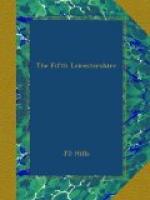Any account of our doings during this month would be incomplete without a reference to our one relaxation. The Divisional Concert Party, started in 1915, had more or less ceased to exist, but in Souastre in a large barn, the 56th Divisional troupe, the “Bow Bells,” performed nightly to crowded houses. Many of us found time to go more than once, and will always remember with pleasure the songs, dances, and sketches, the drummer-ballet-dancer, and the catching melodies of “O Roger Rum” and other nonsense.
Meanwhile, feverish preparations were being made for the coming battle, while the weather was as bad as possible. There never was a wetter June, and the new assembly trenches, the recently cleared or newly dug communication trenches, Derby Dyke, Nottingham, Stafford, Lincoln and Leicester Lanes, Roberts Avenue and “Crawl Boys Lane,” and the cable trenches were always full of water. Work on the gun pits was seriously delayed, and many batteries had to move in before their pits were complete. Fortunately the enemy’s artillery was not too active, and Foncquevillers was almost left alone, though he did one day bombard the Church. No damage was done, except that afterwards the one remaining face of the clock stated the time as 2-15 instead of 11-45, as for the past many months. The village was full of stores and explosives, and almost every cellar held a bomb or ammunition reserve, while the Church crypt was filled with Mills and Stokes mortars under the care of Serjeant Goodman.
On the 24th June our Artillery registration started, and, with early morning bombardments and sudden harassing shoots at night, we made a considerable noise—“the sullen puffs of high explosives bursting in battalions,” as Beach Thomas wrote in the “Daily Mail”—and clearly showed the Boche that we meant business. This apparently was the intention of the Staff, for, as the main attack was to be South of us, it was the object of the IIIrd. Army to attract as many enemy as possible on this the extreme flank of the attack. So successful were we, that we did actually frighten the enemy into reinforcing the Gommecourt area with an extra Division—unfortunate for us who were to attack the place, but doubtless of value to the 4th Army, who would thus have one Division less against them, Gommecourt was naturally strong, and this addition to the garrison made it doubly so, while the Artillery found it very difficult to destroy the wire which was thick along the whole front. The trees in the wood were all wired, and there were strong belts in front of every trench, so that our field guns and trench mortars were kept hard at work almost all day every day in their efforts to cut sufficient gaps for us. The enemy’s guns replied by registering our communication trenches, and then remained silent.




